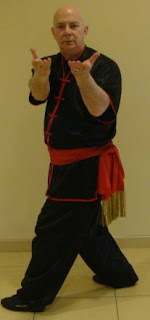by Phillip Starr
To perform these sets properly, there are several things that must be considered. The first is visualization of the opponent(s) and extension of the yi (intention). Remember that extending yi automatically extends qi. Without yi, the form is about as worthless for actual self-defense as jumping jacks.
For many practitioners, they must get over the idea and practice of moving with all the power and spirit of a damp rag. The body should be energized (a technique I call “engaged”, which is discussed in my book, DEVELOPING JIN) and blows must land with force! To do this does not require muscular tension but it does require proper structure.
Moving with speed is critical (no one ever won a fight by moving in slow motion) and the proper rhythm is also vital to mastering the form. Where and when is power applied (fajin)? And you must learn to emit the power very quickly. Without an understanding of how this is done makes your form no different than the forms of shaolinquan or even karate. This is not to say that shaolinquan and karate aren't effective; they definitely are, but their methods of issuing power are considerably different than those used in the neijia (internal martial arts).
The set should follow a particular rhythm. When you engage a flesh-and-blood assailant, combat does NOT adhere to a nice, even, 4-beat rhythm. Your instructor should be able to show you the proper rhythms of the form.
You must never be completely “empty” or “hollow” as you move through the form. You must be “engaged” at all times (that is, the connective tissues are “inflated” with energy; qi). You never hold your breath and inhalations must occur at just the right moments. To do all of these things and remain relaxed (which is a relative term which means, roughly, “not stiff like a wooden soldier”) requires a huge amount of practice over and over. Trust me, you won't get it right – or even close to it – for some time. You need lots and lots of repetition and focus.






















No comments:
Post a Comment